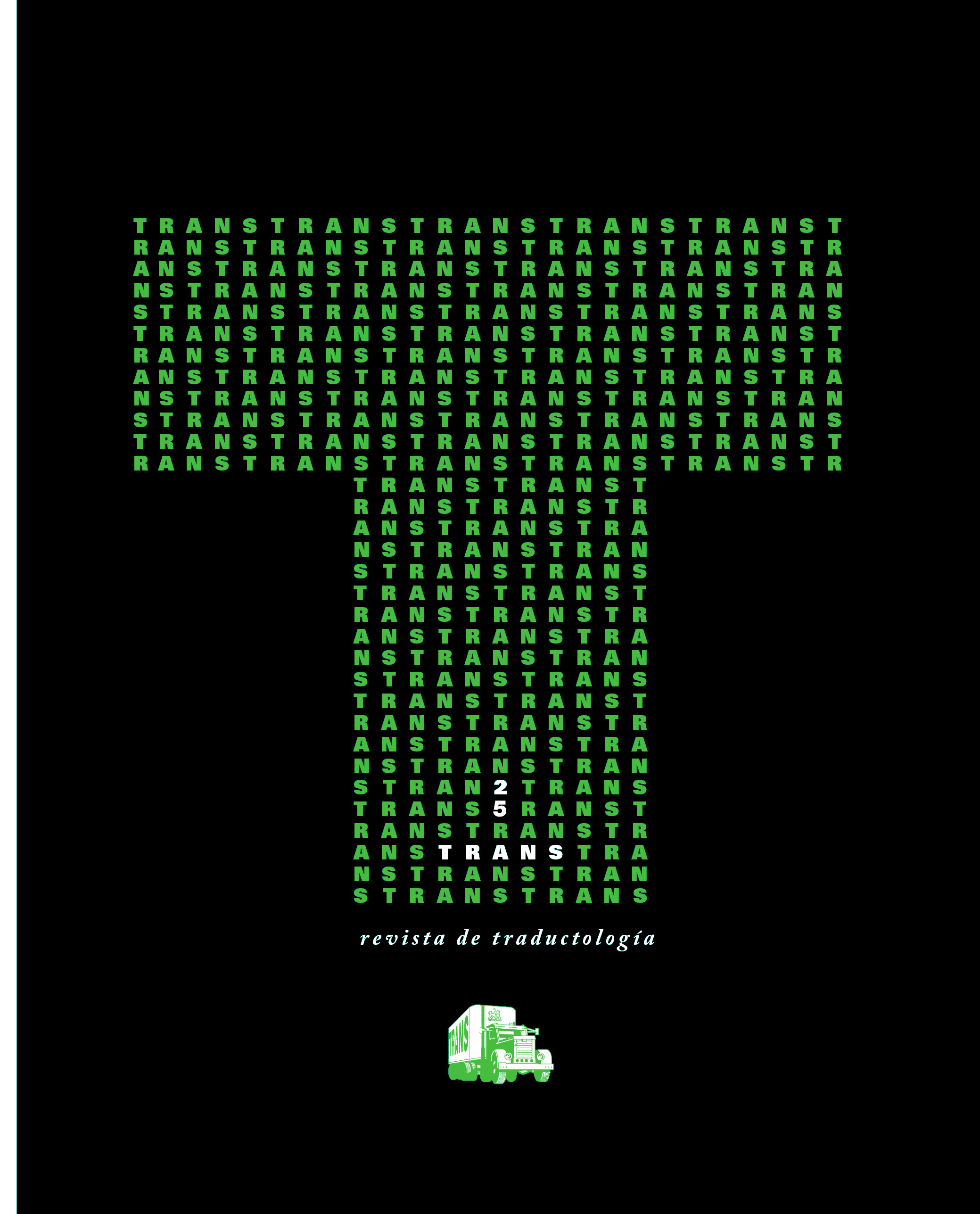The transfer of multilingualism and its functions in Handia
DOI:
https://doi.org/10.24310/TRANS.2021.v1i25.9965Keywords:
Audiovisual Translation, Multilingualism, Basque, HandiaAbstract
This contribution analyzes the film Handia (2017), which uses Basque as main language (L1) and includes several secondary languages (L3) with different presence in the film. The objective is to know how different versions of the film have dealt with multilingualism and if the functions identified in the original product (Tamayo and Manterola, 2019) are maintained. Translation procedures used for the multilingual scenes are analyzed in the subtitled versions in Basque, Spanish and English, the subtitled version in Spanish for deaf and hard of hearing and the dubbed and audio-described versions in Spanish. The case study concludes that all versions are multilingual but some features of the version without extra-diegetic translation are eliminated, such as marking otherness, showing the identity (and evolution) of the characters and producing humor.
Downloads
Metrics
Publication Facts
Reviewer profiles N/A
Author statements
Indexed in
-
—
- Academic society
- N/A
- Publisher
- Universidad de Málaga
References
CORRIUS, Montse y ZABALBEASCOA, Patrick (2011): «Language variation in source texts and their translations the case of L3 in film translation. Language variation in source texts and their translations», Target, 23/1, 113-130.
DE HIGES, Irene (2014): Estudio descriptivo y comparativo de la traducción de filmes plurilingües: el caso del cine británico de migración y diáspora (Tesis doctoral), Castellón: Universitat Jaume I. Recuperado de https://www.tdx.cat/handle/10803/144753 [Fecha de consulta: 9 octubre de 2018].
DELABASTITA, Dirk y Rainier GRUTMAN (2005): «Introduction. Fictional representations of multilingualism and translation», en Dirk DELABASTITA y Rainier GRUTMAN (eds.), Fictionalising translation and multilingualism, LANS-TTS, 4, 11–34.
FUENTES, Adrián (2001): «Estudio empírico sobre la recepción del humor audiovisual», en Lourdes LORENZO y Ana María PEREIRA (eds.), Traducción subordinada (II): El subtitulado, Vigo: Publicacións da Universidade de Vigo, 69-84.
MANTEROLA, Elizabete (2019): «Evolución del cine en euskera y su traducción». Monti, Special Issue, 4, 113-144. doi:10.6035/MonTI.2019.ne4.4.
MARTINEZ SIERRA, Juan José (2004): Estudio descriptivo y discursivo de la traducción del humor en textos audiovisuales. el caso de los Simpson (Tesis doctoral), Castellón: Universitat Jaume I. Recuperado de https://www.tdx.cat/bitstream/handle/10803/10566/martinez.pdf [Fecha de consulta: 15 de julio de 2020].
ROMERO-FRESCO, Pablo (2019): Accessible Filmmaking: Integrating translation and accessibility into the filmmaking process, London: Routledge.
ROMERO FRESCO, Pablo (2020): «The accessible filmmaker and the global film», en Mabel RICHART-MARSET y Francesca CALAMITA (eds.), Traducción y Accesibilidad en los medios de comunicación: de la teoría a la práctica / Translation and Media Accessibility: from Theory to Practice. MonTI, 12, 381-417.
TAMAYO, Ana y Elizabete MANTEROLA (2019): «La creación, la traducción y el tratamiento lingüístico en Handia», Hikma, 18/1, 283-314. Doi: https://doi.org/10.21071/hikma.v18i1.11407.
ZABALBEASCOA, Patrick (2012): «Translating Heterolingual Audiovisual Humor: Beyond the Blinkers of Traditional Thinking», en Javier MUÑOZ-BASOLS, Catarina FOUTO, Laura SOLER GONZÁLEZ and Tyler FISHER (eds.), The Limits of Literary Translation, Kassel: Edition Reichenberger, 317-338.
Downloads
Published
How to Cite
Issue
Section
License
All contents published in TRANS. Revista de Traductología are protected under the Creative Commons Attribution-NonCommercial-ShareAlike 4.0 International (CC BY-NC-SA 4.0) license. All about this license is available in the following link: <http://creativecommons.org/licenses/by-nc-sa/4.0>
Users can copy, use, redistribute, share and exhibit publicly as long as:
- The original source and authorship of the material are cited (Journal, Publisher and URL of the work).
- It is not used for comercial purposes.
- The existence of the license and its especifications are mentioned.
- ShareAlike — If you remix, transform, or build upon the material, you must distribute your contributions under the same license as the original.
There are two sets of authors’ rights: moral and property rights. Moral rights are perpetual prerogatives, unrenounceable, not-transferable, unalienable, imprescriptible and inembargable. According to authors’ rights legislation, TRANS. Revista de Traductología recognizes and respects authors moral rights, as well as the ownership of property rights, which will be transferred to University of Malaga in open access.
The property rights are referred to the benefits that are gained by the use or the dissemination of works. TRANS. Revista de Traductología is published in an open access form and it is exclusively licenced by any means for doing or authorising distribution, dissemination, reproduction, , adaptation, translation or arrangement of works.
Authors are responsable for obtaining the necessary permission to use copyrighted images.













21.png)
